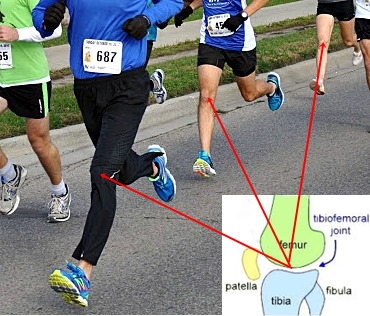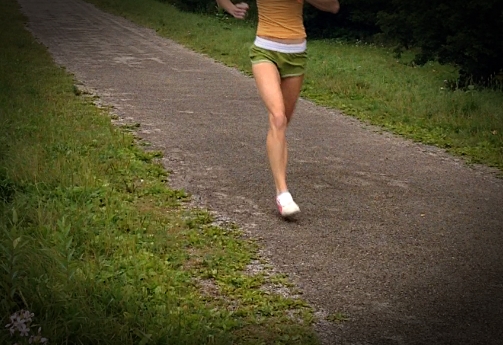Forefoot running reduces tibiofemoral joint pain, particularly in overweight runners, by significantly lowering tibiofemoral compressive forces and knee stiffness compared to heel strike running.
Why Overweight Runners Struggle with Tibiofemoral Joint Pain
The knee is the most common site of injury in runners [1], especially in overweight runners. By zeroing in on the mechanical variables contributing to knee pain, researchers found that a heel strike running style was involved [2].
Heel strike running triggers biomechanical cascades involved in the degenerative process of the knee joint, regardless of the amount of under-heel cushioning in a shoe.
- Increased body weight exposes the knee joint to greater mechanical stress and loading, particularly at the tibiofemoral joint [2], when a heel strike landing is used.

- During this period of braking, a higher body weight increases compression on the knee joint and also increases trauma on the tibiofemoral joint.
Therefore, overweight runners who heel strike literally crush their knees when they run and are more prone to quit running due to persistent knee pain. Good news is, forefoot running relieves tibiofemoral joint pain, not add to it.
How Forefoot Running Prevents Tibiofemoral Joint Pain
Regardless of body weight, forefoot running, a running technique humans are more hardwired for, significantly decreases compressive loading transmitted across the knee simply because knee extension is lower compared to heel running.

When knee extension is reduced, the knee is allowed to flex more, providing a cushioning effect and increases shock absorption at touchdown [3].
Reduced knee extension in forefoot running also reduces the action of which the runner uses the knee joint to propel the body upward and forward. This is why increased body weight is not a risk factor for knee injury in forefoot running -because increased knee flexion prevents the knee from being heavily loaded and augmented impact is neutralized via less deceleration at touchdown.
More From Run Forefoot:
Bad Balance – Find out how soft running shoes destabilizes your landings.
Running Shoes for Forefoot Strikers – Reviews on the best minimalist shoes for forefoot running.
Heel Strike Vs Forefoot Strike – An engineer’s perspective on the two running styles and how one is better than the other and why.
Barefoot is Good – An overview of the amazing benefits of barefoot running.
Why Run Forefoot – Understand that we need forefoot running to keep us healthy.
Daily Deals on Minimalist Running Shoes (enjoy big savings on barefoot inspired running shoes) –
Men’s Vivobarefoot Achilles Running Sandals – Was 60, Now 49
Men’s Vivobarefoot Ultra II – Was 85, Now 69
Men’s Vivobarefoot EVO Pure – Was 110, Now 89
Women’s Vivobarefoot Stealth – Was 135, Now 109
References:
[1]. Messier SP, DeVita P, Cowan RE, Seay J, Young HC, Marsh AP. Do older adults with knee osteoarthritis place greater loads on the knee during gait? A preliminary study. Arch Phys Med Rehabil. 2005;86(4):703–9.
[2]. Messier et al. Risk factor and mechanism of the knee injury in runners. Med Sci Sports Exerc, 2008; 40(11):1873-9.
[3]. Warren BL, Jones CJ. Predicting plantar fasciitis in runners. Med Sci Sports Exerc. 1987;19(1):71–3.
Bretta Riches
BSc Neurobiology; MSc Biomechanics candidate, ultra minimalist runner & founder of RunForefoot. I was a heel striker, always injured. I was inspired by the great Tirunesh Dibaba to try forefoot running. Now, I'm injury free. This is why I launched Run Forefoot, to advocate the health & performance benefits of forefoot running and to raise awareness on the dangers of heel striking, because the world needs to know.
Latest posts by Bretta Riches (see all)
- Does Foot Strike Really Matter in Running? YES! - 17/04/2024
- Heel Lifts Increase Injury in Runners - 16/04/2024
- Are Minimalist Shoes Good for Seniors? YES! - 14/04/2024

Leave a Reply